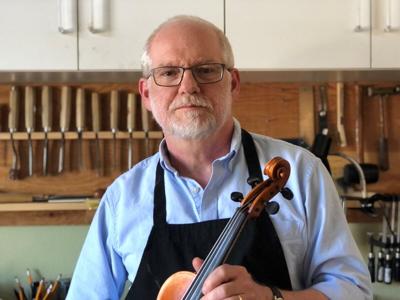Violin making demonstrations at Grateful Vineyard July 25-29
Physician Assistant Craig Danner hadn’t built a violin in more than 35 years, but when the pandemic forced the closure of his Hood River medical clinic in 2020, he rediscovered his passion for musical instrument making.
“When we all first went into lockdown, I didn’t know what to do with myself,” said Danner, “so I pulled out a box of old violin tone wood and hand tools, thinking I’d just ‘fiddle around’ until the pandemic was over.”
Now, 26 months later, he has completed his “pandemic apprenticeship” by finishing his 26th hand-built violin.
“It took a couple months to finish my first violin. I called it ‘The Abomination.’ It was playable, but kind of ugly, to be honest.” While he says he still hasn’t tested positive for COVID, he has definitely been re-infected with the violin-making bug.
In 1985 when he was 26 years old, Danner’s ambition was to build musical instruments professionally. To that end, he attended “The Gault School for The Profession Making and Appreciation of the Stringed Bowed Instruments” in Washington, D.C. But he soon realized it would take years to build a reputation as a luthier sufficient to make a decent living at the craft.
So he switched gears and enrolled in physician assistant school.
“I’ve never regretted that decision,” Danner said. “Being a PA has been an incredible journey. But when the pandemic hit, I had just turned 61, and it suddenly occurred to me that I might have just enough time to start another career.”
After closing his medical practice, Danner quickly went to work converting his clinic into a violin workshop and practice space. “I had a rather expensive medical exam table that could be raised or lowered with a foot pedal. With some creative carpentry, I changed it into a very ergonomic ‘sit-stand’ luthier’s workbench.”
Danner shares his former clinic with his wife, Stacey Danner, who runs her accounting business in one-half of the space. They purchased the Hood River Heights building in 2021 and live in the townhouse above the workshop.
His instruction has almost all been virtual, Danner said.
“There are some incredibly talented and generous master violin makers all over the world. My most influential mentor is Davide Sora from Cremona, Italy, who really inspired the way I make violins. And a master luthier in Sweden, Peter Westerlund, taught me a method for carving the front and back that has really changed my game.”
Even with his formal training at the violin-making school, Danner felt he would need to make more that just a few violins to establish both his own style and a worthwhile reputation.“I decided to take advantage of the pandemic to hole-up and build instruments,” he said.
Danner said a lot of very serious and respected violin makers will make just four to six violins a year. But growing up helping out in his father’s boot factory trained him to be focused and efficient when working with his hands.
“I can finish a violin in about three to four weeks, not counting the varnishing,” he said. “That process can take just as long, but it’s only a half-hour a day.”
Danner started naming his violins in alphabetical order and decided that he would consider his apprenticeship complete when he had reached the letter “Z.” In a traditional violin making school, apprentice luthiers are expected to complete about six instruments over a three year program, which includes additional training in repair and restoration of old instruments.
“At this stage of my life,” Danner said, “I can’t afford to move that slow.”
Danner has decided to concentrate solely on making new instruments. “Repairs can pay the bills, but at the cost of never having time to build something that’s your own.”
Starting with “The Abomination,” then on through monikers such as “Covid,” “Monkey,” “Otto,” and the contrarily named “Viola,” he reached the end of the alphabet with “Zen” this past May. Then, to solidify his skills, he went back to the beginning and fixed mistakes and mishaps he made when he was first starting out.
“My first six fingerboards were pretty thick and clumsy, and my varnishing wasn’t exactly up to Stradivari standards,” Danner said. When he started his apprenticeship, his philosophy was, “keep moving forward,” meaning he would not go back to fix mistakes but simply learn to do better on the next one. “It’s been very inspiring to revisit each instrument. The first five or six were pretty rough and needed substantial makeovers. Going back over them made me realize how much I’ve learned these past two years.”
Danner acknowledges that finishing 26 violins does not mean he has mastered his craft.
“I will probably never consider myself a master violin maker. That’s an honor that requires 30 or 40 years of experience and knowledge-building, and I’m already over 60,” Danner said. “But I do feel I have graduated from apprentice to journeyman. ‘Zen’ is a very fine violin, and I think number 27 is going to be even better.”
To celebrate his progress, Danner will be presenting live violin making demonstrations and all 26 of his violins at The Grateful Vineyard winery in Parkdale from Monday, July 25 through Friday, July 29, from 3-6 p.m., with a special show on Saturday, July 30, from noon to 6 p.m.
Saturday afternoon visitors will have a chance to hear Danner’s violins played live on the outside stage. Brigid’s Crossing will be playing Celtic/Bluegrass/American Folk from 2-3:30 p.m. From 4-6 p.m., violin and vocal virtuoso Michelle Alany will be sharing her blend of soulful Sephardic, Mediterranean and Eastern European-inspired music, accompanied by Mike Danner on accordion and Andrew Alikhanov on clarinet.
The music and demonstrations are free and no reservations are required. However, if you would like a table for tasting and food service, best to make reservations at www.gratefulvineyards.com.
The Grateful Vineyard is located at 6650 Trout Creek Ridge Road, Parkdale.























Commented